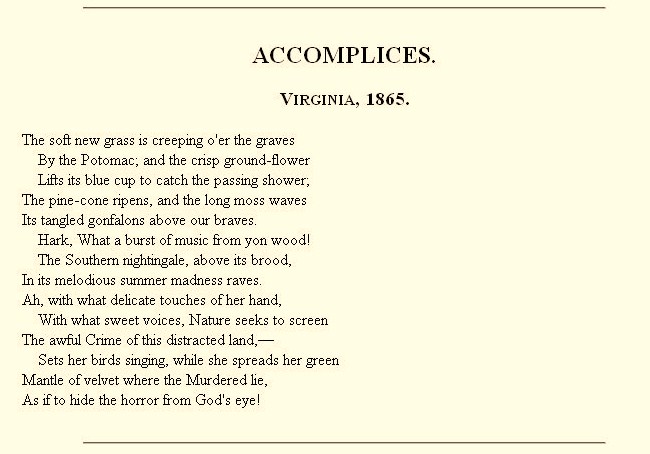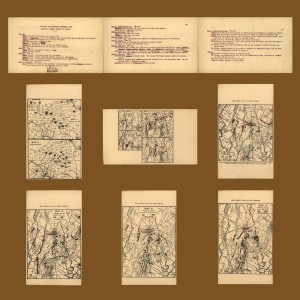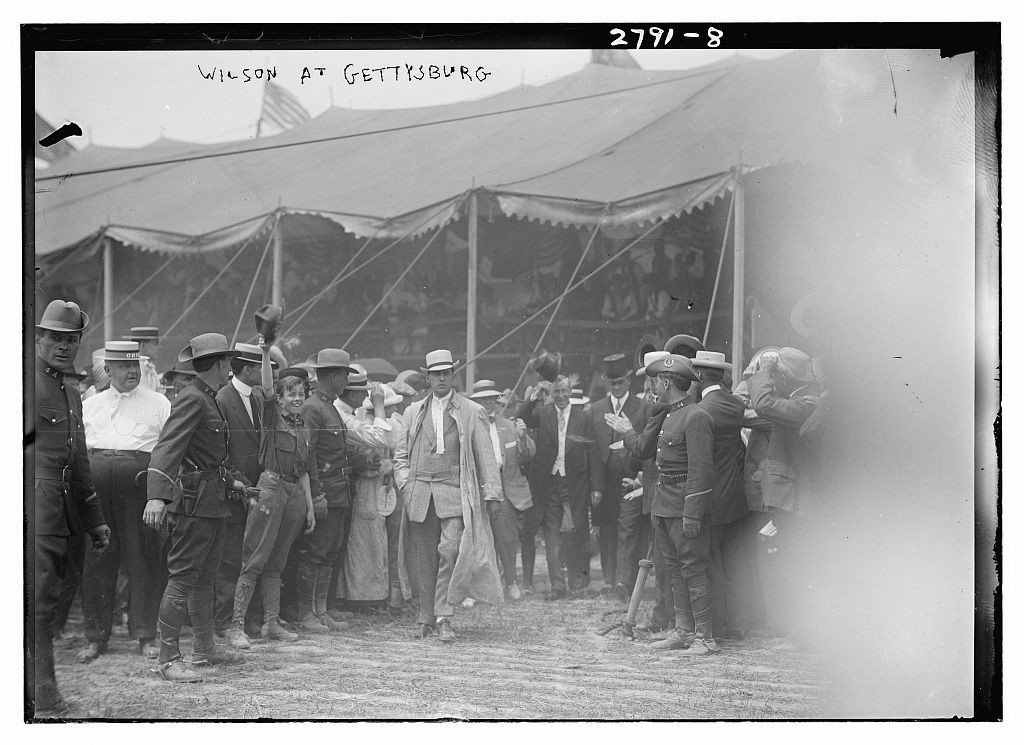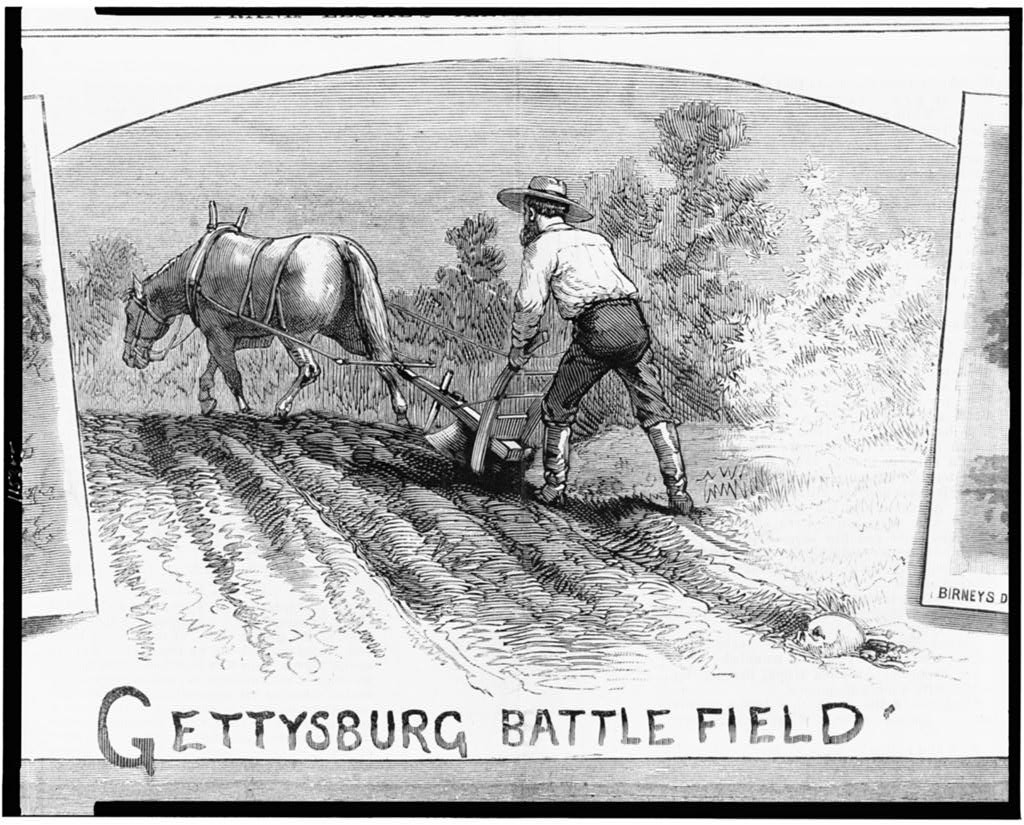The party which went out to bury the dead in the Wilderness battle field, took with them twenty wagon loads of coffins and three weeks’ rations.
![Soldier's graves of the 5th A.C. (i.e. Army Corps) Wilderness battle field (by G. O. Brown, Baltimore, MD : American Scenery (Stereoscopic) 267 West Lexington St., [1865]; LOC: http://www.loc.gov/pictures/item/2015647105/)](https://www.bluegrayreview.com/wp-content/uploads/2015/07/1s03968v-1024x515.jpg)
“Soldier’s graves of the 5th A.C. (i.e. Army Corps) Wilderness battle field” (1865, Library of Congress)
150 years ago CYMON reported that agriculture was having a similar healing effect on a famous battlefield north of Mason-Dixon. From The New-York Times July 10, 1865:
GETTYSBURGH BATTLE-FIELD.; The Field Revisited Old Scenes Revived Appearance of the Battle-Field Two Years After the Conflict Vestiges The Cemetery and Monument Gettysburgh and its People.
GETTYSBURGH, Penn., Tuesday, July 4, 1865.
Our swords are ploughshares and our spears are pruning-hooks. The wand of the husbandman and the influence of the season has so tenderly healed the scars of savage war, that but few vestiges remain of the terrible conflict of two years ago. Here and there fast crumbling breastworks or grass grown lunettes mark the spot where our line of steel and flame hurled back the enemy from the heights he sought to storm; but on other portions of the field, where the battle was fiercest, and where fortune hung quivering over the contestants for two days, there are only fields of waving, golden grain, or green pastures, fresher and richer for the rivulets of blood and battalions of dead that sunk beneath the sod.
But this is now historic ground. The carnage and smoke and dust of battle are not needed to bring back vividly the scenes of those first days of July, ’63. Engraven as upon stone in the memory of every eyewitness and participator, the scene is freshly reenacted as the eye rests upon the now quiet and serene landscape, then so red and hot with the glare of the conflict. And the battle is being “fought over again” with a vigor akin to the struggle of the armed hosts when the onward march of rebellion was forever stayed. Thousands of visitors stroll along the lines, and every hill, every ravine, this stone wall, that clump of trees, yonder woods, Culp’s Hill, Cemetery Hill, Round Top and the peach orchard where SICKLES began the fight, are all before us again as natural as when they were bristling with the cannon and bayonets of the soldiers of the republic.
But though the vestiges of that battle fade away and disappear until nothing is left but the ground on which it was fought, it is nevertheless perpetuated not alone in history but in a grand and holy work first inaugurated by LINCOLN and EVERETT, whose monuments now too tower toward the skies simultaneously with this, which is to mark for ages the resting-place of four thousand other patriots. The country is familiar with the conception of this exceedingly appropriate plan, and will rejoice to know that the work is being steadily pushed forward by the National Monument Association, and another year will see this mausoleum complete in all respects, its grounds highly ornamented, its avenues hard and smooth, and its chaste marble shaft surmounted by the Genius of Liberty and the victor’s wreath of laurel, while war, history, peace and freedom shall be typified in allegorical statues at its base. …
[Much of the long article is a kind of walking tour of the battlefield and a description of the monument that had its cornerstone laid on July 4, 1865, but there was evidence that the human commercial spirit helped clean the field of war relics]
The right of the line, held by SLOCUM, still presents the most visible evidences of the conflict. The breastworks still remain, though in a crumbling condition, for the avarice of the owner of the ground has induced him to demolish these monuments of the battle for the sake of selling the timber cut down by the soldiers for the defence of their line. Culp’s Hill, so well defended by GEARY, is still covered by the forest of oaks and beeches, with their battle faces sadly marred by weather-beaten and slowly-healing wounds. The axe has been busy, and the relic-hunter and speculator in old iron has tramped over every inch of the ground, and now scarce a piece of iron or lead is ever discovered. It is only when a heavy rain washes bare a few battered bullets that a relic of the battle can be found on the grounds. … Passing still further down the road, we alight at the primitive cottage known as “Gen. Meade’s Headquarters,” surprised to find that there is still a board or shingle left. There is not on the line a point of greater interest. Situated within a stone’s throw of our line of battle on the left, subjected to a converging fire of artillery, I remember most vividly the scenes of Thursday and Friday, July 2 and 3, 1863. Headquarters were never so thoroughly and completely “under fire.” A perfect simoon of shot and shell came screeching over the line, and raking this miserable little dwelling; a score of staff horses tied to the very fence which now incloses the humble garden, were killed outright; two or three staff officers wounded, and a hundred narrow escapes; everybody hugging the ground, and wishing themselves as thin as wafers; a thundering, screeching, tearing shower of shells, plunging and bursting everywhere; it seemed impossible that anything should live through such a feu d’enfer. But the cottage stands; it looks not a bit older; a mark of rude treatment only here and there; the fences as they were; the well, which was the only hospitality of the place; the single apple-tree, bearing now a few specimens of red harvest apples, one of which we pluck as a memento; while the poor German widow traffics in relics from the field, and bemoans to visitors the destruction wrought upon her household effects. …
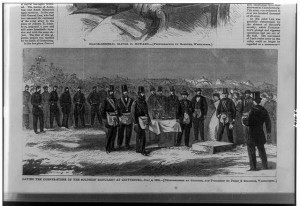
“Laying the corner-stone of the Soldiers’ Monument at Gettysburg, July 4, 1865) (Library of Congress)
The monument whose corner-stone was so imposingly laid to-day, will undoubtedly be reared before the close of the present year, and perhaps by another fourth of July the entire cemetery will be complete in all its respects — the gatekeeper’s house occupied, the drives in good order, the ornamentation of the grounds complete, and the whole plan happily carried out. Descriptions of the cemetery have been heretofore given. There are now buried here nearly 3,000 soldiers, most of whom are known, and their names, company and regiment cut into the granite which forms their head-stone. These head-stones form a continuous line of granite blocks, rising nine inches above the ground, and showing a face or width of ten inches on their upper surface. The designer of the monument is JAMES G. BATTERSON, of Hartford, Conn., who furnishes the following description: …
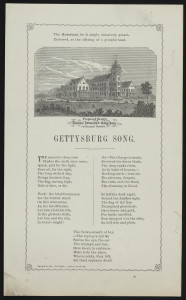
“Proposed design for the National Homestead of Gettysburg for soldier’s orphans” (Library of Congress, Rare Book and Special Collections Division, Alfred Whital Stern Collection of Lincolniana.)
Gettysburgh and its people, on a former occasion, received considerable attention at my hands. This time your correspondent came near receiving considerable attention at the hands of the citizens, of a character not calculated to impress him with the justice of their claims for hospitality and kindness. In other words, it was proposed to resort to lynch law to prove that my statements of two years ago were not correct. But happily the leading and respectable citizens of the place, having the honor of Gettysburgh and a desire to preserve law and order at heart, promptly put down the demonstrations of a few demagogues, and gave your correspondent every opportunity for learning that the claims of the village for hospitality and kindness are not unfounded. Having no desire but to deal justly by all, I must say that notwithstanding the experiences of this occasion, I was able to learn that many of the citizens, on recovering from the paralysis of the battle two years ago, devoted themselves, with self-sacrificing ardor, to the care of the wounded. Some noble women ministered to our men at their own houses, with the shot and shell flying over their heads. The people who acted thus deprecate and condemn as strongly as any one the disreputable conduct heretofore complained of, and are anxious that all should have an opportunity to learn that that class does not constitute the majority of the citizens of Gettysburgh. Personally, the treatment and courtesies extended to me by those with whom I came in contact were of the most cordial and happy character, and convinced not only myself but many other strangers that Gettysburgh has a large population of intelligent, influential and hospitable citizens. CYMON.
I’m pretty sure the citizens of Gettysburg have shown a lot of hospitality over the last century and a half.
And from a Seneca County, New York newspaper in July 1865:
There is said to be some 800 New York soldiers buried in the Gettysburg Cemetery at the present time.
You can find out more about the Gettysburg maps at the Library of Congress. The National Homestead at Gettysburg apparently operated from 1867-1877.
The world might be much bigger than the American Civil War, but so far I haven’t done much else.

![Soldier's graves near cemetery no. 2 (Wilderness) (by G. O. Brown, Baltimore, MD : American Scenery (Stereoscopic) 267 West Lexington St., [1865]; LOC: http://www.loc.gov/pictures/item/2015647109/)](https://www.bluegrayreview.com/wp-content/uploads/2015/07/1s03972v-1024x521.jpg)
![Rebel grounds, near triangle of death. Wilderness field (by G. O. Brown, Baltimore, MD : American Scenery (Stereoscopic) 267 West Lexington St., [1865]; LOC: http://www.loc.gov/pictures/item/2015647112/)](https://www.bluegrayreview.com/wp-content/uploads/2015/07/1s03975v-1024x515.jpg)
